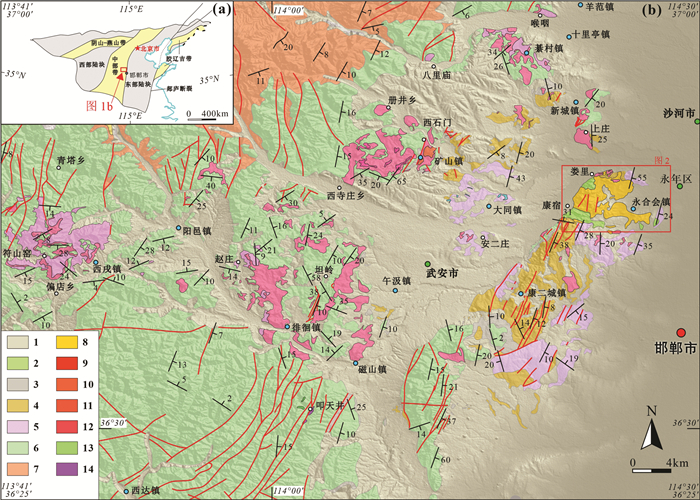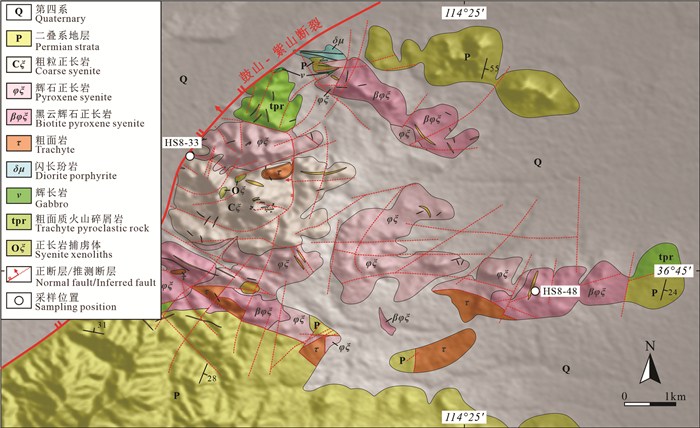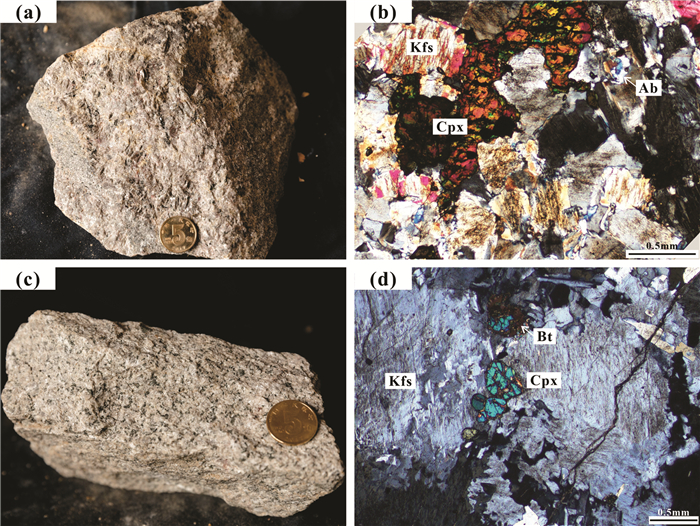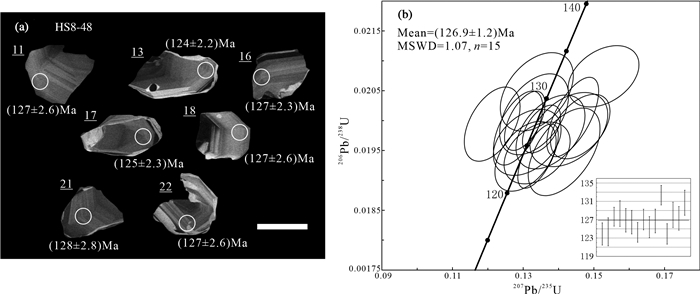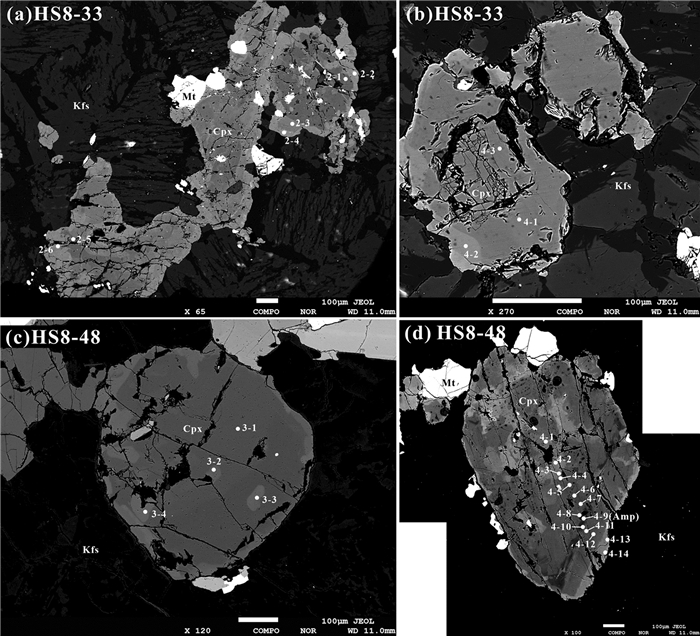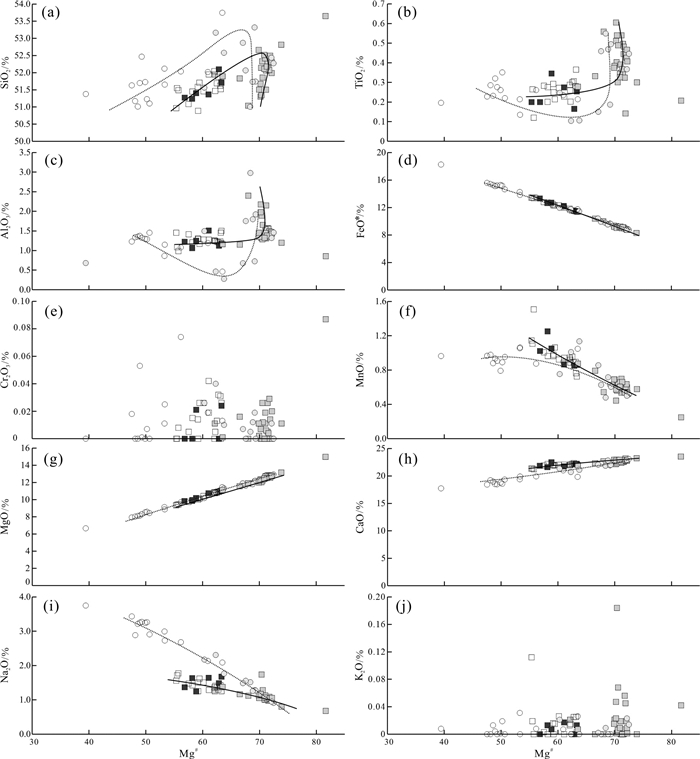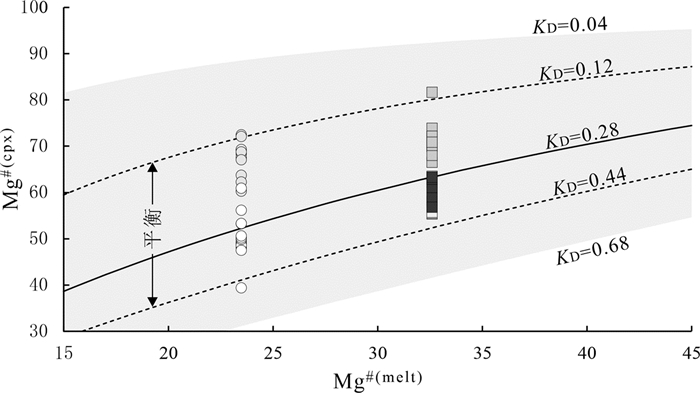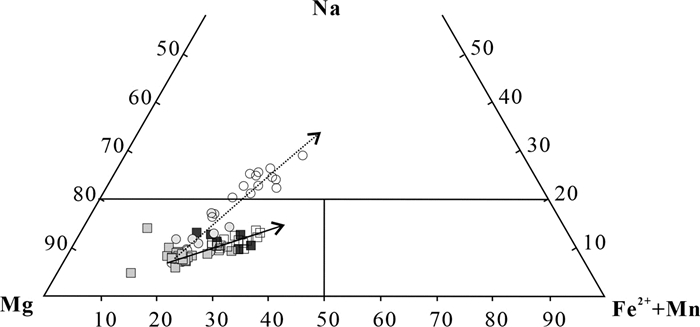Mineral chemistry of clinopyroxene from the Hongshan syenite complex in Wu'an, Hebei Province: Implications for magma evolution
-
摘要:
洪山正长岩杂岩体发育较多的具有核-边(核-幔-边)结构的单斜辉石,通过研究单斜辉石成分的变化,可以获得岩石成因及演化信息。本文在详细野外地质调查的基础上,采用锆石U-Pb年代学、矿物学研究,获得洪山正长岩杂岩体内黑云辉石正长岩锆石U-Pb年龄为(126.9±1.2)Ma,是华北克拉通岩石圈减薄峰期的产物;洪山正长岩杂岩体内辉石正长岩与黑云辉石正长岩中单斜辉石Mg#值分别在39.4~72.5、55.4~81.7,具有较高FeO、Na2O、CaO含量,较低Al2O3、MgO、TiO2含量的特征;单斜辉石总体具有透辉石→霓石的演化趋势,并与熔体达到平衡状态,单斜辉石在初始演化时具有Fe2+对Mg2+的取代关系,随着演化的进行,岩浆更加富钠、富铁,反映了岩浆体系具有高温、中等氧逸度和富碱的特点。结合单斜辉石核-边(核-幔-边)具有截然的接触关系和不连续的化学组成,表明洪山正长岩杂岩体在形成后还经历了富钠、富铁流体的改造,致使单斜辉石形成了具有富钠、富铁的边部,流体可能是由西向东(或者由洪山正长岩杂岩体中部向外部)对杂岩体进行改造的。
Abstract:Hongshan syenite complex has fairly abundant clinopyroxene with core-rim (core-mantle-rim) structure. By studying the changes in the composition of clinopyroxene,information on the genesis and evolution of rocks can be obtained. Based on detailed field geological survey,the authors used zircon U-Pb chronology and mineralogical studies to obtain the biotite pyroxene syenite zircon U-Pb dating data of Hongshan syentite complex,with the age being(126.9±1.2)Ma,suggesting a product of the thinning peak period of the North China Craton lithosphere. The Mg# values of clinopyroxene from pyroxene syenite and biotite pyroxene syenite in the Hongshan syenite complex are 39.4-72.5 and 55.4-81.7,with characteristics of high FeO,Na2O and CaO content and low Al2O3,MgO and TiO2 content. The clinopyroxene generally had the evolutionary trend of diopside and aegirine,and reached an equilibrium state with the melt. The clinopyroxene had a Fe2+ to Mg2+ substitution relationship during the initial evolution. With the evolution,the magma became richer in sodium and iron,which suggests that the magma system had the characteristics of high temperature,medium oxygen fugacity and richness in alkali. Combined with the clinopyroxene core-rim (core-mantle-rim),the authors hold that there existed a clear contact relationship and discontinuous chemical composition. It is shown that,after the formation of the Hongshan syenite complex,it also underwent the transformation of sodium-rich and iron-rich fluids,causing the clinopyroxene to form a sodium-rich and iron-rich rim. The fluid may have modified the complex from west to east or from the inside of the Hongshan syenite complex to the outside.
-
Keywords:
- syenite complex /
- clinopyroxene /
- mineralogy /
- zircon U-Pb chronology /
- Mesozoic /
- magma evolution /
- sodium-rich fluid /
- geological survey engineering /
- Wu'an /
- Hebei Province
-
1. 引言
造山型金矿床作为重要的金矿床类型,其占世界黄金资源的30%以上(Groves et al., 1988)。造山带中形成的造山型金矿床主要位于由挤压或走滑变形中应力相对低的区域,如次级断裂构造中(McCuaig et al., 1988)。大多数造山型金矿床是在绿片岩相变质条件下形成的(Goldfarb et al., 2001, 2015; Deng and Wang, 2016)。造山型金矿的成矿流体和金的来源是至今尚未解决的问题(卢焕章等, 2018)。一般认为成矿流体中的Au(HS)2-络合物是金元素运输及富集的载体(McCuaig et al., 1988)。金成矿流体来源多样,包括:(1)岩石变质作用(Groves et al., 2003); (2)含碳沉积物(Large et al., 2011); (3)岩浆热液(Tomkins et al., 2013); (4)海水(Chang et al., 2008); (5)变质脱水(Phillips and Powell, 2009, 2010)。事实上各个时代的大多数造山型金矿床的成矿流体具有盐度低(≤10%NaCleqv),高碳(CO2 + CH4含量为5%~30%),低Cl和高S含量等特征(卢焕章等, 2018)。而造山型金矿床成矿流体的一致性,说明它们可能来自相同或者是多阶段形成的热液流体(卢焕章, 1991;卢焕章和池国祥, 1995)。此外,造山型金矿的成矿时代也是其研究的热点,争论的焦点主要在于是形成于变质峰期前(Phillips and Powell, 2009, 2010;Tomkins, 2010)还是变质峰期与峰期后(Groves et al., 1998;Goldfarb et al., 2005)。前者主要认为造山带在抬升剥蚀过程中,变质峰期与地壳的深度有关,即越深则达到峰期的时间越晚,且也可能受到之后变质作用的叠加,从而表现出成矿时代比围岩变质时期晚(Phillips and Powell, 2010)。后者则基于造山型金矿的成矿时代统计(Knight et al., 1993, 2000;Dziggel et al., 2010;Kolb et al., 2015),并结合变质时代、蚀变特征、穿切关系等。同时,前人研究发现这些造山型金矿的成矿峰期与陆壳增生速率的峰期和超大陆拼合峰期吻合较好(Goldfarb et al., 2001)。
造山型金矿床也是中国重要的黄金来源,广泛分布于天山造山带(Chen et al., 2012),哀牢山构造带(Zhang et al., 2018),华北克拉通北缘(Hart et al., 2002)和中国西北的造山带(Mao et al., 2000; Zhang et al., 2009;李猛等,2020)。柴达木盆地北缘(简称柴北缘)造山带是中国西北部的重要的造山带之一,含有一系列Au、Cu、Pb和Zn矿床(Zhang et al., 2009)。本区是中国重要的金成矿带,目前发现9个金矿床,金矿化点十余处,远景资源量在300 t以上。前人研究认为这些金矿与造山作用密切相关,但缺乏系统性总结,从而限制了我们对柴北缘造山型金矿的理解。本文在前人研究和最新地质资料的基础上,对柴北缘造山型金矿进行初步探讨,希望能够对柴北缘造山型金矿的找矿工作有所启迪。
2. 地质背景
柴北缘造山带整体走向为西北-东南,长约900 km,宽25~160 km(图 1)。北邻祁连造山带,南接柴达木地块(柴达木盆地)(Song et al., 2014; 蔡鹏捷等,2019)。欧龙布鲁克—牦牛山断裂将柴北缘从欧龙布鲁克地块向北分离(Chen et al., 2009)。在其西北端,造山带被阿尔金断裂切割(Wittlinger et al., 1998)。前人研究表明,柴达木盆地北部在早奥陶世发生俯冲,与祁连地块的碰撞发生在晚奥陶世到中泥盆世(Yang, 2002; 蔡鹏捷等, 2018)。
![]() 1—胜利沟金矿;2—野骆驼泉金矿;3—千枚岭金矿;4—红柳沟金矿;5—青龙沟金矿;6—滩间山金矿;7—鱼卡金矿;8—双口山金矿;9—赛坝沟金矿Figure 1. Schematic map showing the major tectonic units in northwest China (a, modified from Song et al., 2013) and simplified map showing the tectonic framework of the northern Qaidam(b, modified from Zhang et al., 2009)1-Shengligou gold deposit; 2-Yeluotuoquan gold deposit; 3-Qianmeiling gold deposit; 4-Hongliugou gold deposit; 5-Qinglonggou gold deposit; 6-Tanjianshan gold deposit; 7-Yuka gold deposit; 8-Shuangkoushan gold deposit; 9-Saibagou gold deposit
1—胜利沟金矿;2—野骆驼泉金矿;3—千枚岭金矿;4—红柳沟金矿;5—青龙沟金矿;6—滩间山金矿;7—鱼卡金矿;8—双口山金矿;9—赛坝沟金矿Figure 1. Schematic map showing the major tectonic units in northwest China (a, modified from Song et al., 2013) and simplified map showing the tectonic framework of the northern Qaidam(b, modified from Zhang et al., 2009)1-Shengligou gold deposit; 2-Yeluotuoquan gold deposit; 3-Qianmeiling gold deposit; 4-Hongliugou gold deposit; 5-Qinglonggou gold deposit; 6-Tanjianshan gold deposit; 7-Yuka gold deposit; 8-Shuangkoushan gold deposit; 9-Saibagou gold deposit柴北缘的主要岩石地层单位包括古元古界达肯大板岩群、中—新元古界鱼卡河岩群、滩间山岩群和下古生界弧相关的火山和沉积岩(Zhang et al., 2017a, b)。柴北缘作为著名的超高压变质带,前人通过对高压/超高压变质岩(榴辉岩和片麻岩)和花岗岩的地质年代学和地球化学研究,建立了一个大陆碰撞造山带从早期海底俯冲(>440 Ma)、大陆俯冲和碰撞(440~ 420 Ma)、俯冲板块的剥露(420~390 Ma)和最终造山带崩塌(390~360 Ma)的演化模型(Song et al., 2014;张建新等, 2015;Zhang et al., 2017a, b)。
3. 柴北缘造山型金矿床地质概况
俯冲相关增生造山作用的成矿模型预测,柴北缘有利于造山型成矿(Goldfarb et al., 2001, 2015; Deng and Wang, 2016)。柴北缘造山带已发现大量的造山型金矿床,包括胜利沟、野骆驼泉、千枚岭、红柳沟、青龙沟、滩间山、赛坝沟、鱼卡和双口山,以蚀变岩型和石英脉型为主(国家辉, 1998;张德军, 2001, 2005, 2007a, 2007b;Zhang et al., 2009;范贤斌, 2017;孟和, 2017;蔡鹏捷等, 2018)。
柴北缘造山型金矿的地质特征见表 1。总体上,柴北缘的造山带金矿体主要赋存于中元古界、寒武系和奥陶系低品位变质岩发育的剪切带中(Deng and Wang, 2016)。其中胜利沟、野骆驼泉、千枚岭、红柳沟、鱼卡和双口山金矿主要产于寒武—奥陶系滩间山群,青龙沟和滩间山金矿产于中元古界万洞沟群,赛坝沟金矿的赋矿围岩为中粗粒花岗闪长岩-英云闪长岩。基本上所有金矿的围岩蚀变包括硅化、绿泥石化、绢云母化,部分还有碳酸盐化(千枚岭、红柳沟、滩间山、鱼卡、双口山),黄铁绢英岩化(赛坝沟金矿)。多数金矿体的展布与NW向的韧性剪切或断层破碎带相关,少数还与次级构造有关(野骆驼泉、千枚岭、青龙沟、滩间山、双口山)。矿石构造大部分为浸染状、细脉浸染状,部分可见团块状矿石(滩间山和鱼卡)。这些金矿的元素组合均表现为Au-As。
Table 1. Geological characteristics of the orogenic gold deposits in Northern Qaidam
4. 金矿成矿温度特征
对柴北缘造山型金矿与成矿相关的流体包裹体均一温度、冰点、盐度等进行统计(表 2,图 2):野骆驼泉(CO2-H2O型:峰值177~261℃和270~341℃,盐度为1.6%~8.9%;H2O-NaCl型:119~437℃,冰点为-7.8~-0.9℃,盐度为1.6%~11.4%)(张德全等, 2001)、滩间山(CO2-H2O型:峰值在186~250℃和280~296℃,盐度为1.4%~7.9%;H2O-NaCl型:121~ 449℃,冰点为-7.0~-0.9℃,盐度为1.6%~10.5%) (张德全等, 2001)、千枚岭(CO2-H2O型:峰值191~ 243℃,299℃,盐度为2.4%~7.3%;H2O-NaCl型:124~358℃,冰点-6.9~-1.5℃,盐度为2.6%~10.3%) (张德全等, 2001)、青龙沟(CO2- H2O型:200~ 245℃,293~299℃,盐度为1.8%~8.3%;H2O-NaCl型:129~418℃,冰点为-6.0~-0.7℃,盐度为1.2%~ 9.2%)(张德全等, 2001)、红柳沟(CO2-H2O型:213~ 245℃,295℃,盐度为2.4%~8.1%;H2O-NaCl型:129~420℃,冰点为- 5.9~- 1.2℃,盐度为2.1% ~ 9.1%)(张德全等, 2001)、鱼卡(CO2-H2O型:193~ 249℃;H2O- NaCl型:188~285℃,冰点为- 7.5~-0.7℃,盐度为1.22%~11.10%)(范贤斌, 2017;蔡鹏捷, 2018)、双口山(CO2-H2O型:252~290℃,320~ 358℃;H2O-NaCl型:161~365.6℃,冰点为-5.6~ -3.0℃,盐度为1.91%~14.25%)(孟和, 2017)、胜利沟(H2O- NaCl型:120~209℃,206~385℃,冰点为-9.7~-1.8℃,盐度为3.06%~13.62%)(黄亚, 2013)。
Table 2. Temperature measurement data of fluid inclusions of orogenic gold deposits in the northern Qaidam (datas from Zhang et al., 2001; Huang, 2013; Fan, 2017; Meng, 2017; Cai et al., 2018)
![]() Figure 2. Histogram showing homogenization temperature of fluid inclusions of the orogenic gold deposits in the northern Qaidam (after Zhang et al., 2001; Huang, 2013; Fan, 2017; Meng, 2017; Cai et al., 2018c)
Figure 2. Histogram showing homogenization temperature of fluid inclusions of the orogenic gold deposits in the northern Qaidam (after Zhang et al., 2001; Huang, 2013; Fan, 2017; Meng, 2017; Cai et al., 2018c)不难看出,成矿流体的均一在各个矿床之间存在一定的差异。这种差异应该是与成矿作用时的压力-温度不同有关,也与围岩的组成有关。但这些矿床的成矿温度还是在200~400℃,仅有几十度的差别,均在造山型金矿的成矿温度(卢焕章等, 2018)。大部分矿床(点) 中呈双峰态分布, 只有少部分矿床(点)中呈单峰态分布。张德全(2007)对柴北缘—东昆仑金矿流体包裹体研究认为,这可能与不同造山时期的成矿作用有关,且对应了低盐度的H2O-CO2-NaCl-CH4(晚加里东碰撞造山期)和H2O-CO2-NaCl±CH4(晚华力西—印支碰撞造山期)两种不同的成矿流体。
一般认为金成矿具有多个成矿阶段, 从早期的高温阶段到后期的低温阶段(卢焕章等, 2018)。金矿化主要包含了4个阶段:①乳白色石英黄铁矿阶段;②含金石英黄铁矿阶段;③含金多金属硫化物石英阶段;④碳酸盐阶段(卢焕章等, 2018)。前人对柴北缘造山型金矿流体包裹体的研究主要针对与金矿的成矿流体相关第二和第三阶段。对柴北缘造山型金矿的流体包裹体显微观察,均发现有富CO2型、含CO2水溶液型(CO2-H2O型)和水溶液型(H2O-NaCl型) 三类,这与典型的造山型金矿中流体包裹体类型是一致的(Groves et al., 1998; Kerrich et al., 2000; Hagemann and Cassidy, 2000; 陈衍景等, 2007)。
5. 金成矿流体与物质来源
5.1 氢、氧同位素特征
利用与成矿相关的氢、氧同位素,能够有效地揭示成矿流体的来源,区分其来源岩浆水、变质水或大气降水,从而有助于判别流体的演化轨迹和矿床成因(杨利亚等, 2013)。造山型金矿的成矿流体往往经历了长距离迁移,其氢、氧同位素组成除了反映源区性质之外,可能表征沿着流体通道的水/岩反应、源区和围岩或后期流体的混合特征(Ridley and Diamond, 2000; Beaudoin and Pitre, 2005; 蔡鹏捷, 2019)。
柴北缘造山型金矿成矿流体中δ18OH2O-SNOW = -1.7‰ ~ 10.31‰和δDV- SMOW = -113.8 ‰~ -41.6 ‰ (表 3,图 3),其中滩间山金矿δ18OH2O-SNOW = 9.15‰ ~ 10.31‰,δDV-SMOW=-69.9‰ ~ -50‰;青龙沟金矿δ18OH2O - SNOW =- 1.7‰ ~ 5.5‰,δDV- SMOW=- 95.1‰ ~ -71.4‰;鱼卡金矿δ18OH2O-SNOW =5.2‰ ~ 6.01‰,δDV-SMOW=-58.5‰ ~-41.6‰;双口山金矿δ18OH2O-SNOW = 5.75‰ ~ 6.45‰,δDV-SMOW=-113.8‰ ~ -99.8‰。柴北缘这些金矿的H-O同位素特征,是无法用单一大气水或原生岩浆水的参与解释,只有是在复杂的造山过程中变质流体受到岩浆水及大气水等共同作用所导致。从图 3也可见,整个柴北缘金矿的H-O同位素基本上也与华北克拉通北缘、小秦岭、西秦岭、东昆仑等造山带中的造山型金矿范围重叠。
表 3 柴北缘造山型金矿H-O同位素Table 3. δ18O and δD values of the orogenic gold deposits in the northern Qaidam
![]() 图 3 柴北缘造山型金矿δD与δ18Owater比值图(底图据Deng and Wang, 2016)1—双口山金矿;2—滩间山金矿;3—青龙沟金矿;4—鱼卡金矿Figure 3. δD (‰) vs. δ18Owater (‰) diagram of the orogenic gold deposits in the northern Qaidam (modified from Deng and Wang, 2016)1-Shuangkoushan gold deposit; 2-Tanjianshan gold deposit; 3- Qinglonggou gold deposit; 4-Yuka gold deposit
图 3 柴北缘造山型金矿δD与δ18Owater比值图(底图据Deng and Wang, 2016)1—双口山金矿;2—滩间山金矿;3—青龙沟金矿;4—鱼卡金矿Figure 3. δD (‰) vs. δ18Owater (‰) diagram of the orogenic gold deposits in the northern Qaidam (modified from Deng and Wang, 2016)1-Shuangkoushan gold deposit; 2-Tanjianshan gold deposit; 3- Qinglonggou gold deposit; 4-Yuka gold deposit5.2 硫、铅同位素特征
硫化物的硫同位素组成对于追踪成矿物质来源和约束成矿过程是非常有效的(Hodkiewicz et al., 2009)。柴北缘金矿中含金黄铁矿的δ34S在0.5‰~ 11‰,主要集中在5‰~9‰(表 4,图 4),其中滩间山金矿δ34S为5.31‰~8.54‰;青龙沟金矿δ34S为5.0‰ ~11.0‰;鱼卡金矿δ34S为0.5‰~7.4‰;双口山金矿δ34S为6.0‰ ~10.0‰;红柳沟金矿δ34S为3.9‰ ~4.4‰。总体柴北缘金矿黄铁矿的δ34S与金矿类型进行对比,主要落在造山型金矿和卡林型金矿范围内,源区特征主要落在变质岩类型的范围内(图 4),推测成矿流体在上升过程中与通道围岩发生水-岩作用而产生的混合硫,总体上指示了带内的金矿应属于造山型金矿。
表 4 柴北缘造山型金矿S同位素特征Table 4. Analytical results of S isotope of the orogenic gold deposits in Northern Qaidam
![]() 图 4 柴北缘造山型金矿与其他类型S同位素对比(据Deng and Wang, 2016修改)Figure 4. Comparison of S isotopes between orogenic gold deposits in the northern margin of Qaidam and other types of gold deposits
图 4 柴北缘造山型金矿与其他类型S同位素对比(据Deng and Wang, 2016修改)Figure 4. Comparison of S isotopes between orogenic gold deposits in the northern margin of Qaidam and other types of gold deposits矿石的铅同位素同样是一类对成矿来源的有效示踪工具(Doe and Stacey, 1974; Zartman and Doe, 1981)。柴北缘金矿中黄铁矿或共生方铅矿的206Pb/204Pb为18.238~19.296,207Pb/204Pb为15.547~ 15.773,208Pb/204Pb为37.918~38.978,∆β为14.15~ 29.79,∆γ为11.95~51.92(表 5)。其中胜利沟金矿中方铅矿的206Pb/204Pb为18.300~18.374,207Pb/204Pb为15.602~15.688,208Pb/204Pb为38.054~38.346,∆β为14.15~20.28,∆γ为11.95~18.38(表 5);滩间山金矿中黄铁矿的206Pb/204Pb为18.476~19.296,207Pb/204Pb为15.547~15.641,208Pb/204Pb为37.918~38.211,∆β为18.55~24.41,∆γ为28.66~36.42(表 5);鱼卡金矿中黄铁矿的206Pb/204Pb为18.238~18.62,207Pb/204Pb为15.59~ 15.618,208Pb/204Pb为38.039~38.775,∆β为16.96~ 18.78,∆γ为15.29~34.82(表 5);双口山金矿中方铅矿的206Pb/204Pb为18.437~18.567,207Pb/204Pb为15.617~ 15.773,208Pb/204Pb为38.466~38.978,∆β为15.33~ 29.79,∆γ为32.26~51.92,黄铁矿的206Pb/204Pb为18.435~18.460,207Pb/204Pb为15.604~15.634,208Pb/204Pb为38.431~38.531,∆β为18.24~20.91,∆γ为26.03~ 30.10(表 5)。柴北缘金矿含金矿物的Pb同位素投点可见主要落在了上地壳和造山带演化线之间(图 5),这些Pb同位素特征说明柴北缘金矿的成矿物质大多来源于地幔—上地壳的混合作用(图 6),且一定程度上受到了岩浆作用的影响,也指示了其应该与造山作用相关。
表 5 柴北缘造山型金矿Pb同位素特征Table 5. Pb-isotpic compositions and characteristic parameters of orgen gold deposits in the northern Qaidam
![]() 图 5 柴北缘造山型金矿Pb同位素构造图解(底图据Zartman and Doe, 1981)1—双口山金矿;2—滩间山金矿;3—胜利沟金矿;4—鱼卡金矿Figure 5. Pb isotope diagrams of the orogenic gold deposits in the northern Qaidam (basic diagram modified from Zartman and Doe, 1981)Pb isotope diagrams of the orogenic gold deposits in the northern Qaidam (basic diagram modified from Zartman and Doe, 1981)
图 5 柴北缘造山型金矿Pb同位素构造图解(底图据Zartman and Doe, 1981)1—双口山金矿;2—滩间山金矿;3—胜利沟金矿;4—鱼卡金矿Figure 5. Pb isotope diagrams of the orogenic gold deposits in the northern Qaidam (basic diagram modified from Zartman and Doe, 1981)Pb isotope diagrams of the orogenic gold deposits in the northern Qaidam (basic diagram modified from Zartman and Doe, 1981)![]() 图 6 柴北缘造山型金矿Pb同位素Δβ-Δγ图解(底图据朱炳泉等, 1998)1—地幔源Pb; 2—上地壳源Pb; 3—上地壳与地幔混合的俯冲带Pb (3a—岩浆作用; 3b—沉积作用); 4—化学沉积型Pb; 5—海底热水作用Pb; 6—中深变质作用Pb; 7—深变质下地壳Pb; 8—造山带Pb; 9—古老页岩上地壳Pb; 10—退变质作用Pb;11—双口山金矿;12—滩间山金矿;13—胜利沟金矿;14—鱼卡金矿Figure 6. Pb isotope Δβ-Δγ diagram of the orogenic gold deposits in the northern Qaidam (basic diagram modified from Zhu et al., 1998)1- mantle lead; 2-upper crust lead; 3- subduction zone lead mixed with upper crust and mantle(3a -magmatism; 3b- deposition); 4- chemical deposition lead; 5- submarine hot water lead; 6-mesometamorphism lead; 7- katametamorphism lower crust lead; 8-orogenic belt lead; 9- ancient shale upper crust lead; 10- retrograde metamorphism lead; 11-Shuangkoushan gold deposit; 12-Tanjianshan gold deposit; 13-Shengligou gold deposit; 14-Yuka gold deposit
图 6 柴北缘造山型金矿Pb同位素Δβ-Δγ图解(底图据朱炳泉等, 1998)1—地幔源Pb; 2—上地壳源Pb; 3—上地壳与地幔混合的俯冲带Pb (3a—岩浆作用; 3b—沉积作用); 4—化学沉积型Pb; 5—海底热水作用Pb; 6—中深变质作用Pb; 7—深变质下地壳Pb; 8—造山带Pb; 9—古老页岩上地壳Pb; 10—退变质作用Pb;11—双口山金矿;12—滩间山金矿;13—胜利沟金矿;14—鱼卡金矿Figure 6. Pb isotope Δβ-Δγ diagram of the orogenic gold deposits in the northern Qaidam (basic diagram modified from Zhu et al., 1998)1- mantle lead; 2-upper crust lead; 3- subduction zone lead mixed with upper crust and mantle(3a -magmatism; 3b- deposition); 4- chemical deposition lead; 5- submarine hot water lead; 6-mesometamorphism lead; 7- katametamorphism lower crust lead; 8-orogenic belt lead; 9- ancient shale upper crust lead; 10- retrograde metamorphism lead; 11-Shuangkoushan gold deposit; 12-Tanjianshan gold deposit; 13-Shengligou gold deposit; 14-Yuka gold deposit6. 柴北缘造山型金成矿时代
前人对柴北缘构造带中的金矿相关的成岩成矿时代进行了厘定(表 6):野骆驼泉金矿成矿时代为(246.0±3.0)Ma(张德全等, 2005);青龙沟金矿成矿时代为(409.4±2.3)Ma(张德全等, 2005)、(410.3± 5.8)Ma(张德全等, 2005)、274.6 Ma(林文山等, 2006);滩间山金矿成矿时代为409.4 Ma(张德全等., 2001)、401 Ma(张德全等, 2001)、(394±6)Ma (Li, 2011)、385.8 Ma(崔艳合等, 2000)、(356±2.8) Ma(贾群子等, 2013)、(350.4 ± 3.2)Ma(张博文, 2010)、(344.7±2)Ma(李世金, 2011)、(344±2.2)Ma(张博文, 2010)、(330±24.3)Ma(张德全等, 2001)、(288.9±7.3)Ma(崔艳合等, 2000)、(289.6±6)Ma(崔艳合等, 2000)、288 Ma(Zhang et al., 2009)、(284.04±2.95)Ma(张德全等, 2005)、284 Ma(张德全等, 2005)、(275.9 ± 7.2)Ma(崔艳合等, 2000)、(268.94 ± 4.31)Ma(崔艳合等, 2000)、268.9 Ma (Zhang et al., 2009)、209 Ma(国家辉, 1998);鱼卡金矿成矿时代为(376.9±4.0)Ma、(387.5±7.2)Ma(范贤斌, 2017);双口山金矿成矿时代为(357.7±5.28)Ma (孟和, 2017);赛坝沟金矿成矿时代为(425.5±2.1) Ma(丰成友等, 2002)、(426±2)Ma(张德全等, 2005)、(210±3)Ma(丰成友等, 2002)。上述成矿时代指示了柴北缘造带中的金矿大多与复合造山过程有关。
表 6 柴北缘造山型金矿相关成岩与成矿时间Table 6. Diagenetic and metallogenic ages of orogenic gold deposits in the northern Qaidam
将柴北缘金矿成矿时期与岩浆活动和构造运动分期进行对比(图 7),综合前人研究,可见寒武—奥陶纪时期,柴北缘的洋盆逐渐关闭,洋壳俯冲导致岛弧火山岩(滩间山岩群)的形成,洋壳俯冲结束后,柴达木地块与欧龙布鲁克微陆块开始碰撞,形成了加里东期的柴北缘碰撞造山带(赵志新,2018),造山期后的一系列岩浆活动奠定了柴北缘造山型金矿形成的基础(张德全等, 2001, 2005;Zhang et al., 2009)。整个柴北缘造山型金矿的成矿期主要集中在426~376 Ma、357~330 Ma和288~246 Ma三个时期。第一个成矿期与区域的加里东期碰撞造山过程相关,第二成矿期与陆内裂解的岩浆活动有关,第三成矿期则与晚华力西—印支期造山过程有关。其中加里东晚期,柴达木陆块向祁连陆块的俯冲由正向俯冲变成斜向俯冲,导致区域上形成了一条右行剪切走滑构造带,同时柴北缘这种应力的转变也进一步促进了岩浆活动的加剧及地层的褶皱变形,从而导致成矿热液流体沿原有构造体系发生叠加富集(丰成友等, 2002; 张德全等, 2005)。从时间上,不难看出,第一时期是属于柴北缘超高压变质峰期之后,该期矿床成矿时代的差异应该是所处不同位置及成矿深度导致。第二成矿期属于柴北缘碰撞造山后地壳增厚后减薄时期,岩浆活动对金矿的进一步富化。第三成矿期则是古特提斯洋的开合导致该区新的造山活动,热液与岩浆新的叠加作用。事实上,一般认为挤压或者从伸展到挤压的转换阶段,才是造山型金矿最有利的形成时期(王庆飞等,2019)。柴北缘大部分的造山型金矿都属于一次造山作用的产物,而带内滩间山、青龙沟、塞巴沟等经历了两期以上,其中滩间山金矿的三期复合成矿作用可能是导致其成为柴北缘最大金矿的原因。
![]() 图 7 柴北缘构造事件、岩浆活动与金矿成矿时代耦合图(据赵志新,2018修改)1—青龙沟金矿;2—滩间山金矿;3—鱼卡金矿;4—双口山金矿;5—赛坝沟金矿;6—野骆驼泉金矿;7—镁质钙性-钙碱性花岗岩;8—钙碱性花岗岩;9—钙碱-碱钙性花岗岩;10—钙碱花岗岩、拉斑质基性岩;11—碱性花岗岩Figure 7. Coupling diagram showing tectonic event, magmatic activity and metallogenic age of gold deposits in the northern Qaidam (modified from Zhao Zhixin, 2018)1-Qinglonggou gold deposit; 2-Tanjianshan gold deposit; 3-Yuka gold deposit; 4-Shuangkoushan gold deposit; 5-Saibagou gold deposit; 6- Yeluotuoquan gold deposit; 7-Magnesian calc alkaline granite; 8-Calc alkaline granite; 9-Calc alkaline- alkali calcium granite; 10-Calc alkaline granite, tholeiitic basic rock; 11-Alkaline granite
图 7 柴北缘构造事件、岩浆活动与金矿成矿时代耦合图(据赵志新,2018修改)1—青龙沟金矿;2—滩间山金矿;3—鱼卡金矿;4—双口山金矿;5—赛坝沟金矿;6—野骆驼泉金矿;7—镁质钙性-钙碱性花岗岩;8—钙碱性花岗岩;9—钙碱-碱钙性花岗岩;10—钙碱花岗岩、拉斑质基性岩;11—碱性花岗岩Figure 7. Coupling diagram showing tectonic event, magmatic activity and metallogenic age of gold deposits in the northern Qaidam (modified from Zhao Zhixin, 2018)1-Qinglonggou gold deposit; 2-Tanjianshan gold deposit; 3-Yuka gold deposit; 4-Shuangkoushan gold deposit; 5-Saibagou gold deposit; 6- Yeluotuoquan gold deposit; 7-Magnesian calc alkaline granite; 8-Calc alkaline granite; 9-Calc alkaline- alkali calcium granite; 10-Calc alkaline granite, tholeiitic basic rock; 11-Alkaline granite7. 结论
(1) 柴北缘造山型金矿主要赋存在中元古代、寒武系和奥陶系低品位变质岩发育的剪切带中,且多数矿体的展布与NW向的构造相关。
(2) 柴北缘造山型金矿大部分矿床(点) 成矿温度呈双峰态分布, 只有少部分矿床(点)中呈单峰态分布,指示了受到多期流体作用。
(3) 柴北缘造山型金矿的成矿流体中δ18OH2O-SMOW=-1.7‰ ~ 10.31‰和δDV-SMOW = -113.8 ‰ ~ -41.6 ‰,指示其变质流体受到岩浆水及大气水等共同作用。含金硫化物(黄铁和方铅矿)的δ34S在0.5‰ ~11‰,主要集中在5‰ ~9‰,206Pb/204Pb为18.238~19.296,207Pb/204Pb为15.547~15.773,208Pb/204Pb为37.918~38.978,指示了成矿物质来源于地幔-上地壳,且一定程度上都受到了岩浆作用的影响。
(4)柴北缘的复合造山运动导致造山型金矿存在(426~376)Ma、(357~330)Ma和(288~246)Ma三个成矿期。
-
图 1 华北克拉通基底构造单元划分图(a, 据Zhao et al., 2005)和邯邢地区区域地质图(b, 据资料❶, ❷修编)
1—第四系;2—白垩纪火山岩地层;3—三叠纪沉积地层;4—二叠纪沉积地层;5—石炭纪沉积地层;6—奥陶纪沉积地层;7—前寒武变质地层;8—正长岩;9—二长岩;10—二长闪长岩;11—闪长岩;12—角闪闪长岩;13—橄榄辉长岩;14—辉橄岩
Figure 1. Tectonic subdivision of the North China Craton (a, after Zhao et al., 2005) and geological map of the Handan-Xintai area (b, modified from Zhao et al., 2008❶; Zhang et al., 2014❷)
1-Quaternary; 2-Cretaceous volcanic strata; 3- Triassic sedimentary strata; 4-Permian sedimentary strata; 5-Carboniferous sedimentary strata; 6-Ordovician sedimentary strata; 7-Precambrian metamorphic strata; 8-Syenite; 9-Monzonite; 10-Monzodiorite; 11-Diorite; 12-Hornblende diorite; 13-Olivine gabbro; 14-Pyroxene peridotite
图 5 洪山正长岩杂岩体中代表性单斜辉石的BSE图像
a, b—辉石正长岩(HS8-33);c, d—黑云辉石正长岩(HS8-48);Cpx—单斜辉石;Kfs—钾长石;Amp—角闪石;Mt—磁铁矿
Figure 5. Representative BSE images of the of clinopyroxene from the Hongshan syenite complex
a, b-Pyroxene syenite (HS8-33); c, d-Biotite pyroxene syenite (HS8-48); Cpx-clinopyroxene; Kfs-K-feldspar; Amp-Amphibole; Mt-Magnetite
图 6 洪山正长岩杂岩体单斜辉石系列划分图解(a)和单斜辉石分类图解(b、c)(据Morimoto, 1988;邱家骧和廖群安, 1996修改)
Wo—硅灰石; En—斜顽辉石; Fs—斜铁辉石; WEF—Wo-En-Fs端元; Jd—硬玉; Ae—霓石; 图b中演化趋势分别为: 1—钙铁辉石→透辉石(Baie-des-Moutons正长岩质杂岩体早期正长岩中,Lalonde and Marin, 1983); 2—透辉石→钙铁辉石(日本碱性玄武岩系列, Aoki, 1964; Shiant Isles岩体,Gibb, 1972); 3—透辉石→霓石(Shonkin Sag岩体, Nash and Wilkinson, 1970); 4—透辉石→易变辉石(日本拉斑质玄武岩,Kuno, 1955)
Figure 6. Discrimination diagram of the series for pyroxene (a) and discrimination diagram of clinopyroxene (b, c) from the Hongshan syenite complex (modified from Morimoto, 1988; Qiu Jiaxiang and Liao Qun'an, 1996)
Wo-Wollastonite; En-Clinoenstatite; Fs-Clinoferro; WEF-Wo-En-Fs end member; Jd-Jadeite; Ae-Aegirine; Fig. b shown for comparison exhibiting crystallization trends of other different types of magmas; 1- Hedenbergite → diopside (Baie -des- Moutons syenitic complex, early- group syenites. After Lalonde and Marin, 1983); 2- Diopside → hedenbergite (Japanese alkaline basalt series, after Aoki, 1964; Shiant lsles sill, Gibb, 1972); 3- Diopside → aegirine (Shonkin Sag laccolith, after Nash and Wilkinson, 1970); 4- Diopside → ferropigeonite (Japanese tholeiite series, after Kuno, 1955)
图 8 洪山正长岩杂岩体单斜辉石罗德图(据Rhodes et al., 1979; Di et al., 2020修改, 图例同图 6)
Figure 8. Rhodes diagram for clinopyroxenes form the Hongshan syenite complex (modified from Rhodes et al., 1979; Di et al., 2020, symbols as for Fig. 6)
图 9 洪山正长岩杂岩体单斜辉石Mg-Na-(Fe2++Mn)图解(据Eby et al., 1998修改, 图例同图 6)
Figure 9. Mg-Na-(Fe2++Mn) diagram for clinopyroxenes from the Hongshan syenite complex (modified from Eby et al., 1998, symbols as for Fig. 6)
表 1 洪山正长岩杂岩体锆石LA-ICP-MS U-Pb年龄数据
Table 1 LA-ICP-MS U-Pb zircon ages of Hongshan syenite complex

表 2 洪山正长岩杂岩体中单斜辉石电子探针数据(%)
Table 2 Electron microprobe analyses of clinopyroxene from Hongshan syenite complex (%)

-
Andersen T. 2002. Correction of common lead in U-Pb analyses that do not report 204Pb[J]. Chemical Geology, 192(1/2):59-79. https://www.sciencedirect.com/science/article/abs/pii/S000925410200195X
Aoki K I. 1964. Clinopyroxenes from alkaline rocks of Japan[J]. American Mineralogist:Journal of Earth and Planetary Materials, 49(9/10):1199-1223. http://cn.bing.com/academic/profile?id=a6ae5588155525e3e1c066ffd2334324&encoded=0&v=paper_preview&mkt=zh-cn
Bai Zhimin. 2000. Mineral chemistry and genetic significance of clinopyroxenes from the Mesozoic volcanic rocks in Western Hills of Beijing[J]. Acta Petrologica et Mineralogica, 19(2):174-184 (in Chinese with English abstract). http://www.wanfangdata.com.cn/details/detail.do?_type=perio&id=yskwxzz200002010
Chen B, Tian W, Jahn B M, Chen Z C. 2008. Zircon SHRIMP U-Pb ages and in-situ Hf isotopic analysis for the Mesozoic intrusions in South Taihang, North China craton:Evidence for hybridization between mantle-derived magmas and crustal components[J]. Lithos, 102(1/2):118-137. http://cn.bing.com/academic/profile?id=6b68908e5e5b30564cdc9fc3603d55d4&encoded=0&v=paper_preview&mkt=zh-cn
Chen Chunliang, Jiang Sihong, Liang Qingling, Liu Yuan, Han Ning. 2014. The Hf Iisotopic characteristics of the zircons from Wulingshan complex in Hebei and regional comparative study[J]. Geoscience, 28(4):663-673(in Chinese with English abstract). http://en.cnki.com.cn/Article_en/CJFDTotal-XDDZ201404001.htm
Chen L, Zheng Y F, Zhao Z F. 2018. Geochemical insights from clinopyroxene phenocrysts into the effect of magmatic processes on petrogenesis of intermediate volcanics[J]. Lithos, 316:137-153. http://www.wanfangdata.com.cn/details/detail.do?_type=perio&id=9c4c1c3cd520cebe6d0ef6ab0586a685
Deng X D, Li J W, Wen G. 2015. U-Pb geochronology of hydrothermal zircons from the early Cretaceous iron skarn deposits in the Handan-Xingtai district, North China craton[J]. Economic Geology, 110(8):2159-2180 doi: 10.2113/econgeo.110.8.2159
Di Y K, Tian W, Chen M M, Li Z F, Chu Z Y, Liang J. 2020. A method to estimate the pre-eruptive water content of basalts:Application to the Wudalianchi-Erkeshan-Keluo volcanic field, Northeastern China[J]. American Mineralogist:Journal of Earth and Planetary Materials, 105(2):149-161.
Dobosi G, Fodor R V. 1992. Magma fractionation, replenishment, and mixing as inferred from green-core clinopyroxenes in Pliocene basanite, southern Slovakia[J]. Lithos, 28(2):133-150. http://cn.bing.com/academic/profile?id=80724b36defb568e92216eae1d285a4f&encoded=0&v=paper_preview&mkt=zh-cn
Duan Youqiang, Zhang Zhengwei, Yang Xiaoyong. 2015. The continental dynamics of Zhangshiying pluton at the southern margin of the North China Craton:Evidence from geochemical, zircon U-Pb geochronology and Hf isotopic compositions[J]. Acta Petrologica Sinica, 31(7):1995-2008(in Chinese with English abstract).
Eby G N, Woolley A R, Din V, Platt G. 1998. Geochemistry and petrogenesis of nepheline syenites:Kasungu-Chipala, Ilomba, and Ulindi nepheline syenite intrusions, North Nyasa alkaline province, Malawi[J]. Journal of Petrology, 39(8):1405-1424. doi: 10.1093/petroj/39.8.1405
Huang Xiaolong, Xu Yigang, Yang Qijun, Chen Linli. 2007. Genesis of compositional zoning of clinopyroxene phenocrysts in the Wozhong Late Eocene high-Mg ultrapotassic lavas, western Yunnan, China:Magma replenishment-mixing process[J]. Geological Journal of China Universities, 13(2):250-260 (in Chinese with English abstract).
Huo Tengfei, Yang Debin, Shi Jiangpeng, Xu Wenliang, Yang Haotian. 2016. Petrogenesis of the Early Cretaceous alkali-rich intrusive rocks in the central North China Block:Constraints from zircon UPb chronology and Sr-Nd-Hf isotopes[J]. Acta Petrologica Sinica, 32(3):697-712(in Chinese with English abstract).
Gao S, Rudnick R L, Xu W L, Yuan H L, Liu Y S, Walker R J, Puchtel I S, Liu X M, Huang H, Wang X R, Yang J. 2008. Recycling deep cratonic lithosphere and generation of intraplate magmatism in the North China Craton[J]. Earth and Planetary Science Letters, 270(1/2):41-53. http://www.wanfangdata.com.cn/details/detail.do?_type=perio&id=069b1caaa140b2d4abd620f71a2cb0bf
Gao S, Rudnick R L, Yuan H L, Liu X M, Liu Y S, Xu W L, Ling W L, Ayers J, Wang X C, Wang Q H. 2004. Recycling lower continental crust in the North China craton[J]. Nature, 432(7019):892-897. doi: 10.1038/nature03162
Gibb F G F. 1973. The zoned clinopyroxenes of the Shiant Isles sill, Scotland[J]. Journal of Petrology, 14(2):203-230. doi: 10.1093/petrology/14.2.203
Goleń M, Puziewicz J, Matusiak-Małek M, Ntaflos T. 2015.Clinopyroxene phenocrysts from the Księginki nephelinite (SW Poland)[J]. Geoscience Records, 1(1/2):1-15. http://www.wanfangdata.com.cn/details/detail.do?_type=perio&id=georec-2015-0001
Jiang Shaoyong, Zhao Kuidong, Jiang Yaohui, Ling Hongfei, Ni Pei. 2006. New type of tin mineralization related to granite in South China:Evidence from mineral chemistry, element and isotope geochemistry[J]. Acta Petrologica Sinica, 22(10):2509-2516 (in Chinese with English abstract).
Jiang Shaoyong, Li Liang, Zhu Bi, Ding Xin, Jiang Yaohui, Gu Lianxing, Ni Pei. 2008.Geochemical and Sr-Nd-Hf isotopic compositions of granodiorite from the Wushan copper deposit, Jiangxi Province and their implications for petrogenesis[J]. Acta Petrologica Sinica, 24(8):1679-1690 (inChinese with English abstract). http://www.wanfangdata.com.cn/details/detail.do?_type=perio&id=ysxb98200808002
Le Bas M J. 1962. The role of aluminum in igneous clinopyroxenes with relation to their parentage[J]. American Journal of Science, 260(4):267-288. http://cn.bing.com/academic/profile?id=67035106cc1af6c6c76a5a1ecb1175c4&encoded=0&v=paper_preview&mkt=zh-cn
Li Suimin, Li Yucheng, Zhao Shumei, Zhang Liangliang, Wang Junge, Han Tengfei, Sun Zhiwei, Han Yuchou, Li Tong. 2020. Ar-Ar and U-Pb ages of Hongshan copper deposit, Handan and their limitation on mineralization time[J/OL]. Geology in China, [2020-02-04]: 1-17(in Chinese with English abstract).
Liu Xin, Tang Yanjie. 2018. The characteristics and implication of the zonation in clinopyroxene phenocrysts from the Yaojiazhuang ultramafic-syenitic complex, northwestern Hebei Province[J]. Acta Petrologica Sinica, 34(11):3315-3326 (in Chinese with English abstract). http://www.wanfangdata.com.cn/details/detail.do?_type=perio&id=ysxb98201811015
Luo Zhaohua, Deng Jinfu, Han Xiuqing. 1999. Characteristics of Magmatic Activities and Orogenic Process of Taihangshan Intraplate Orogen[M]. Beijing:Geological Publishing House, 1-132 (in Chinese).
Ludwig K R. 2003. ISOPLOT 3.0: A geochronological toolkit for Microsoft Excel[J]. Berkeley Geochronology Center Special Publications, 4.
Marks M, Halama R, Wenzel T, Markl G. 2004. Trace element variations in clinopyroxene and amphibole from alkaline to peralkaline syenites and granites:Implications for mineral-melt trace-element partitioning[J]. Chemical Geology, 211(3/4):185-215. http://cn.bing.com/academic/profile?id=24b8ec91737a42bbbf2b790c1c2896be&encoded=0&v=paper_preview&mkt=zh-cn
Morimoto N. 1988. Nomenclature of pyroxenes[J]. Mineralogy and Petrology, 39(1):55-76. doi: 10.1007/BF01226262
Nash W P, Wilkinson J F G. 1970. Shonkin Sag Laccolith, Montana[J]. Contributions to Mineralogy and Petrology, 25(4):241-269. doi: 10.1007/BF00399286
Niu Xiaolu, Chen Bin, Ma Xu. 2009. Clinopyroxenes from the Fanshan pluton, Hebei[J]. Acta Petrologica Sinica, 25(2):359-373(in Chinese with English abstract). http://www.wanfangdata.com.cn/details/detail.do?_type=perio&id=ysxb98200902010
Putirka K D. 2008. Thermometers and barometers for volcanic systems[J]. Reviews in mineralogy and geochemistry, 69(1):61-120. doi: 10.2138/rmg.2008.69.3
Qiu Jiaxiang, Liao Qunan. 1987. The main characteristics and petrological significance of low pressure clinopyroxenes in the Cenozoic basalts from eastern China[J]. Acta Petrologica Sinica, 3(4):1-9 (in Chinese with English abstract).
Rhodes J M, Dungan M A, Blanchard D P, Long P E. 1979. Magma mixing at mid-ocean ridges:evidence from basalts drilled near 22°N on the Mid-Atlantic Ridge[J]. Tectonophysics, 55(1/2):35-61.
Su Shangguo, Jian Dongchuan, Xie Yuchun, Luo Zhaohua, Jiang Junyi, Liu Lulu, Huo Yanan, Cui Xiaoliang, Zhang Bo, Gu Dapeng, Wang Yu. 2017. The practice of thematic geological mapping in medium-large scale for intermediate-basic intrusive rocks:A case study of the Wu'an iron ore concentration area, Hebei Province[J]. Geological Bulletin of China, 36(11):1987-1998(in Chinese with English abstract).
Sun J F, Zhang J H, Yang J H, Yang Y H, Chen S. 2019. Tracing magma mixing and crystal-melt segregation in the genesis of syenite with mafic enclaves:Evidence from in situ zircon Hf-O and apatite Sr-Nd isotopes[J]. Lithos, 334:42-57. http://cn.bing.com/academic/profile?id=c9e3223a1142b334d5432389a3c6d79e&encoded=0&v=paper_preview&mkt=zh-cn
Wang Y, Sun L X, Zhou L Y, Xie Y T. 2018. Discussion on the relationship between the Yanshanian Movement and cratonic destruction in North China[J]. Science China (Earth Sciences), 61:499-514. doi: 10.1007/s11430-017-9177-2
Wang Yaying, Cai Jianhui, Yan Guohan, Yan Zhijiao, Song Jianqiang. 2015. Geochemistry and mineral characteristics of Zijinshan alkaline complex from Linxian, Shanxi Province and its Petrogenesis[J]. Geoscience, 29(4):896-911 (in Chinese with English abstract). http://www.wanfangdata.com.cn/details/detail.do?_type=perio&id=xddz201504020
Wu Fuyuan, Xu Yigang, Gao Shan, Zheng Jianping. 2008.Lithospheric thinning and destruction of the North China Craton[J]. Acta Petrologica Sinica, 24(6):1145-1174(in Chinese with English abstract). http://cn.bing.com/academic/profile?id=8529d40ce3ff5806bc85560db8f6b765&encoded=0&v=paper_preview&mkt=zh-cn
Wu Fuyuan, Yang Jinhui, Liu Xiaoming. 2005. Geochronological framework of the Mesozoic granitic magmatism in the Liaodong Peninsula, Northeast China[J]. Geological Journal of China Universities, 11(3):305-317(in Chinese with English abstract). http://www.wanfangdata.com.cn/details/detail.do?_type=perio&id=gxdzxb200503003
Xu Wenliang, Yang Chenghai, Yang Debin, Pei Fuping, Wang Qinghai, Ji Weiqiang. 2006. Mesozoic high-Mg diorites in eastern North China craton:Constraints on the mechanism of lithospheric thinning[J]. Earth Science Frontiers, 13(2):120-129(in Chinese with English abstract). http://cn.bing.com/academic/profile?id=18e1c5e30efd9a7dc5488913e0c5b52f&encoded=0&v=paper_preview&mkt=zh-cn
Xu Wenliang, Yang Debin, Pei Fuping, Yu Yang. 2009. Petrogenesis of Fushan high-Mg# diorites from the southern Taihang Mts. in the central North China Craton:Resulting from interaction of peridotite-melt derived from partial melting of delaminated lower continental crust[J]. Acta Petrologica Sinica, 25(8):1947-1961(in Chinese with English abstract). http://www.wanfangdata.com.cn/details/detail.do?_type=perio&id=ysxb98200908019
Xu Y G, Li H Y, Pang C J, He B. 2009. On the timing and duration of the destruction of the North China Craton[J]. Chinese Science Bulletin, 54(19):3379-3396. http://www.wanfangdata.com.cn/details/detail.do?_type=perio&id=kxtb-e200919004
Yan Guohan, Cai Jianhui, Ren Kangxu, He Guoqi, Mou Baolei, Xu Baoliang, Li Fengtang, Yang Bin. 2007. Intraplate extensional magmatism of North China Craton and break-up of three supercontinents and their deep dynamics[J]. Geological Journal of China Universities, 13(02):161-174(in Chinese with English abstract). http://www.wanfangdata.com.cn/details/detail.do?_type=perio&id=gxdzxb200702003
Yan G H, Xu B L, Mu B L, Wang G Y, Chang Z S, Chen T L, Zhao Y C, Wang X F, Zhang R H, Qiao G S, Chu Z Y. 2000. Alkaline intrusives at the east foot of the Taihang-Da Hinggan Mountains:Chronology, Sr, Nd and Pb isotopic characteristics and their implications[J]. Acta Geologica Sinica, 74(4):774-780.
Yang H J, Frey F A, Clague D A, Garcia M O. 1999. Mineral chemistry of submarine lavas from Hilo Ridge, Hawaii:implications for magmatic processes within Hawaiian rift zones[J]. Contributions to Mineralogy and Petrology, 135(4):355-372. doi: 10.1007/s004100050517
Yang X K, Chao H X, Volkova N I, Zheng M L, Yao W H. 2009.Geochemistry and SHRIMP geochronology of alkaline rocks of the Zijinshan massif in the eastern Ordos basin, China[J]. Russian Geology and Geophysics, 50(9):751-762. doi: 10.1016/j.rgg.2009.08.002
Yang Zhaoyao, Xu Yaoming, Zhu Zhiyong, Zhou Wei, Bai Cheng. 2015. Mineral chemistry of pyroxene in lamprophyre from the Nangang prospecting area in the Jiurui ore district of Jiangxi Province:Implication for magma evolution[J]. Acta Petrologica Sinica, 31(3):675-685(in Chinese with English abstract).
Yuan H L, Gao S, Liu X M, Li H M, Günther D, Wu F Y. 2004.Accurate U-Pb age and trace element determinations of zircon by laser ablation-inductively coupled plasma-mass spectrometry[J]. Geostandards and Geoanalytical Research, 28(3):353-370. doi: 10.1111/j.1751-908X.2004.tb00755.x
Zhang Bo, Su Shangguo, Mo Xuanxue, Feng Shaochong, Wu Yue, Jiang Xiao, Feng Yanfang, Liu Jiangtao. 2020. Magmatic response to lithospheric thinning of the North China Craton: Evidence from porphyritic aegirite-bearing syenite in Wuan, Hebei, China[J/OL]. Earth Science Frontiers, [2020-01-22]: 1-14 (in Chinese with English abstract).
Zhang H F, Sun M, Zhou X H, Ying J F. 2005. Geochemical constraints on the origin of Mesozoic alkaline intrusive complexes from the North China Craton and tectonic implications[J]. Lithos, 81(1/4):297-317. http://www.wanfangdata.com.cn/details/detail.do?_type=perio&id=655aa3a0f89c1cc9822036ceec6c947e
Zhai M G, Zhu R X, Liu J M, Meng Q R, Hou Q L, Hu S B, Liu W, Li Z, Zhang H F, Zhang H F. 2004. Time range of Mesozoic tectonic regime inversion in eastern North China Block[J]. Science in China Series D:Earth Sciences, 47(2):57-65. http://cn.bing.com/academic/profile?id=bfed048a533eb31b4148954304047eb9&encoded=0&v=paper_preview&mkt=zh-cn
Zhao G C, Sun M, Wilde S A, Li S Z. 2005. Late Archean to Paleoproterozoic evolution of the North China Craton:Key issues revisited[J]. Precambrian Research, 136(2):177-202. doi: 10.1016/j.precamres.2004.10.002
Zheng Y F, Xu Z, Zhao Z F, Dai L Q. 2018. Mesozoic mafic magmatism in North China:Implications for thinning and destruction of cratonic lithosphere[J]. Science China Earth Sciences, 61(4):353-385. doi: 10.1007/s11430-017-9160-3
Zou Jinxi, Liu Xianfan, Deng Jianghong, Deng Jianghong, Li Chunhui, Huang Yupeng, Dong Yi, Yi Liwen. 2012. Mineralogical composition characteristics and geological significance of the clinopyroxene from ultrabasic-basic rocks at Luoji village, Shangri-La County, Yunnan Province[J]. Acta Petrologica et Mineralogica, 31(5):701-711 (in Chinese with English abstract). http://www.wanfangdata.com.cn/details/detail.do?_type=perio&id=yskwxzz201205008
Zhu R X, Chen L, Wu F Y, Liu J L. 2011. Timing, scale and mechanism of the destruction of the North China Craton[J]. Science China (Earth Sciences), 54(6):789-797. doi: 10.1007/s11430-011-4203-4
Zhu R X, Xu Y G. 2019. The subduction of the west Pacific plate and the destruction of the North China Craton[J]. Science China Earth Sciences), 62(9):1340-1350. doi: 10.1007/s11430-018-9356-y
Zhu R X, Xu Y G, Zhu G, Zhang H F, Xia Q K, Zheng T Y. 2012a.Destruction of the North China Craton[J]. Science China (Earth Sciences), 55(10):1565-1587. doi: 10.1007/s11430-012-4516-y
Zhu R X, Yang J H, Wu F Y. 2012b. Timing of destruction of the North China Craton[J]. Lithos, 149:51-60. doi: 10.1016/j.lithos.2012.05.013
白志民. 2000.北京西山中生代火山岩中单斜辉石矿物化学及成因意义[J].岩石矿物学杂志, (2):174-184. doi: 10.3969/j.issn.1000-6524.2000.02.010 陈春良, 江思宏, 梁清玲, 刘源, 韩宁. 2014.河北雾灵山杂岩体锆石Hf同位素特征及其区域对比研究[J].现代地质, 28(4):663-673. doi: 10.3969/j.issn.1000-8527.2014.04.001 段友强, 张正伟, 杨晓勇. 2015.华北克拉通南缘张士英岩体大陆动力学背景:来自地球化学, 锆石U-Pb年龄和Hf同位素的证据[J].岩石学报, 31(7):1995-2008. http://www.cnki.com.cn/Article/CJFDTotal-YSXB201507015.htm 黄小龙, 徐义刚, 杨启军, 陈林丽. 2007.滇西莴中晚始新世高镁富钾火山岩中单斜辉石斑晶环带结构的成因:岩浆补给-混合过程[J].高校地质学报, (2):250-260. doi: 10.3969/j.issn.1006-7493.2007.02.009 霍腾飞, 杨德彬, 师江朋, 许文良, 杨浩田. 2016.华北地块中部早白垩世富碱侵入岩的成因:锆石U-Pb年代学和Sr-Nd-Hf同位素制约[J].岩石学报, 32(3):697-712. http://www.wanfangdata.com.cn/details/detail.do?_type=perio&id=ysxb98201603005 蒋少涌, 赵葵东, 姜耀辉, 凌洪飞, 倪培. 2006.华南与花岗岩有关的一种新类型的锡成矿作用:矿物化学, 元素和同位素地球化学证据[J].岩石学报, 22(10):2509-2516. 蒋少涌, 李亮, 朱碧, 丁昕, 姜耀辉, 顾连兴, 倪培. 2008.江西武山铜矿区花岗闪长斑岩的地球化学和Sr-Nd-Hf同位素组成及成因探讨[J].岩石学报, 24(8):1679-1690. http://www.wanfangdata.com.cn/details/detail.do?_type=perio&id=ysxb98200808002 李随民, 李玉成, 赵淑梅, 张良良, 王俊革, 韩腾飞, 孙志伟, 韩玉丑, 李樋. 2020.邯郸洪山铜矿Ar-Ar和U-Pb年龄及其对成矿时代的限定[J/OL].中国地质, [2020-02-04]: 1-17. 刘鑫, 汤艳杰. 2018.冀西北姚家庄超镁铁岩-正长岩杂岩体中辉石的环带特征及意义[J].岩石学报, 34(11):3315-3326. http://www.wanfangdata.com.cn/details/detail.do?_type=perio&id=ysxb98201811015 罗照华, 邓晋福, 韩秀卿. 1999.太行山造山带岩浆活动及其造山过程反演[M].北京:地质出版社, 1-132. 牛晓露, 陈斌, 马旭. 2009.河北矾山杂岩体中单斜辉石的研究[J].岩石学报, 25(2):359-373. http://www.wanfangdata.com.cn/details/detail.do?_type=perio&id=ysxb98200902010 邱家骧, 廖群安. 1996.浙闽新生代玄武岩的岩石成因学与Cpx矿物化学[J].火山地质与矿产, 17(1):16-25. http://www.wanfangdata.com.cn/details/detail.do?_type=perio&id=QK199600241803 苏尚国, 简东川, 谢玉淳, 罗照华, 蒋俊毅, 刘璐璐, 霍延安, 崔晓亮, 张波, 顾大鹏, 王玉. 2017.中基性侵入岩中-大比例尺专题地质填图实践——以河北武安铁矿集区填图试点为例[J].地质通报, 36(11):1987-1998. doi: 10.3969/j.issn.1671-2552.2017.11.009 王亚莹, 蔡剑辉, 阎国翰, 闫志娇, 宋建强. 2015.山西临县紫金山岩体地球化学、矿物学特征及岩体成因[J].现代地质, 29(4):896-911. doi: 10.3969/j.issn.1000-8527.2015.04.020 吴福元, 杨进辉, 柳小明. 2005.辽东半岛中生代花岗质岩浆作用的年代学格架[J].高校地质学报, 11(3):305-317. doi: 10.3969/j.issn.1006-7493.2005.03.003 吴福元, 徐义刚, 高山, 郑建平. 2008.华北岩石圈减薄与克拉通破坏研究的主要学术争论[J].岩石学报, 24(6):1145-1174. http://www.wanfangdata.com.cn/details/detail.do?_type=perio&id=ysxb98200806001 许文良, 杨承海, 杨德彬, 裴福萍, 王清海, 纪伟强. 2006.华北克拉通东部中生代高Mg闪长岩——对岩石圈减薄机制的制约[J].地学前缘, 13(2):120-129. doi: 10.3321/j.issn:1005-2321.2006.02.010 许文良, 杨德彬, 裴福萍, 于洋. 2009.太行山南段符山高镁闪长岩的成因——拆沉陆壳物质熔融的熔体与地幔橄榄岩反应的结果[J].岩石学报, 25(8):1947-1961. http://www.wanfangdata.com.cn/details/detail.do?_type=perio&id=ysxb98200908019 阎国翰, 蔡剑辉, 任康绪, 何国琦, 牟保磊, 许保良, 李凤棠, 杨斌. 2007.华北克拉通板内拉张性岩浆作用与三个超大陆裂解及深部地球动力学[J].高校地质学报, 13(2):161-174. doi: 10.3969/j.issn.1006-7493.2007.02.003 杨照耀, 徐耀明, 朱志勇, 周巍, 柏成. 2015.江西九瑞矿集区南港成矿远景区煌斑岩中辉石矿物成分特征与岩浆演化过程[J].岩石学报, 31(3):675-685. http://www.wanfangdata.com.cn/details/detail.do?_type=perio&id=ysxb98201503003 张波, 苏尚国, 莫宣学, 冯少憧, 伍月, 蒋校, 冯艳芳, 刘江涛. 2020.华北克拉通减薄的岩浆岩响应: 来自河北武安洪山含霓石斑状正长岩的证据[J/OL].地学前缘, [2020-01-22]: 1-14. 邹金汐, 刘显凡, 邓江红, 邓江红, 李春辉, 黄玉蓬, 董毅, 易立文. 2012.云南香格里拉洛吉乡基性-超基性岩中单斜辉石矿物成分特征及其地质意义[J].岩石矿物学杂志, 31(5):701-711. doi: 10.3969/j.issn.1000-6524.2012.05.008 -
期刊类型引用(9)
1. 俞军真,郑有业,王永才,王建国,马波,贾翠霞,张琳琳. 柴北缘青龙沟金矿床闪长玢岩锆石年代学、黄铁矿原位硫同位素和微量元素特征及找矿启示. 黄金. 2024(11): 9-17+136 .  百度学术
百度学术
2. 甄世民,查钟健,王大钊,刘家军,庞振山,程志中,薛建玲,王江,白海军,李阳,陈超. 河北张宣地区中山沟金矿成矿流体特征及其对侵入岩型碲金矿床的限定. 中国地质. 2023(02): 605-621 .  本站查看
本站查看
3. 赵呈祥,薛春纪,赵晓波,李鹏,刘洋涛,李君阳,赵伟策,李健. 柴北缘造山带滩间山金矿田多期侵入岩年代学及其地质意义. 地质与勘探. 2023(03): 591-607 .  百度学术
百度学术
4. 张灵桧. 柴达木盆地西北缘交通社金矿地质特征及找矿前景. 中国锰业. 2023(04): 83-88 .  百度学术
百度学术
5. 王进寿,潘彤,薛万文,李鹏,安永尉,田永革,雷晓清,余福承. 青海省柴北缘成矿带区域成矿规律综述. 矿床地质. 2022(05): 917-938 .  百度学术
百度学术
6. 徐永利,郑有业,许荣科,严康,左恒斌. 基于成矿元素复杂度的地球化学数据处理方法在找矿实践中的应用——以柴北缘造山带绿梁山地区为例. 黄金. 2022(11): 25-30 .  百度学术
百度学术
7. 唐名鹰,何宗围,朱德全,张宇,高振华,董振昆,李小东. 柴北缘赛坝沟金矿床硫、铅同位素组成:对成矿物质来源的指示. 矿床地质. 2021(01): 117-127 .  百度学术
百度学术
8. 童海奎,龙灵利,马永胜,仓索南尖措,吴鸿梅. 青海大柴旦镇尕日力根砾岩型金矿成矿特征研究. 矿产勘查. 2021(03): 534-541 .  百度学术
百度学术
9. 李顺庭,龙灵利,王宁. 韧性剪切带型金矿研究进展. 矿产勘查. 2021(04): 802-813 .  百度学术
百度学术
其他类型引用(1)




 下载:
下载:






